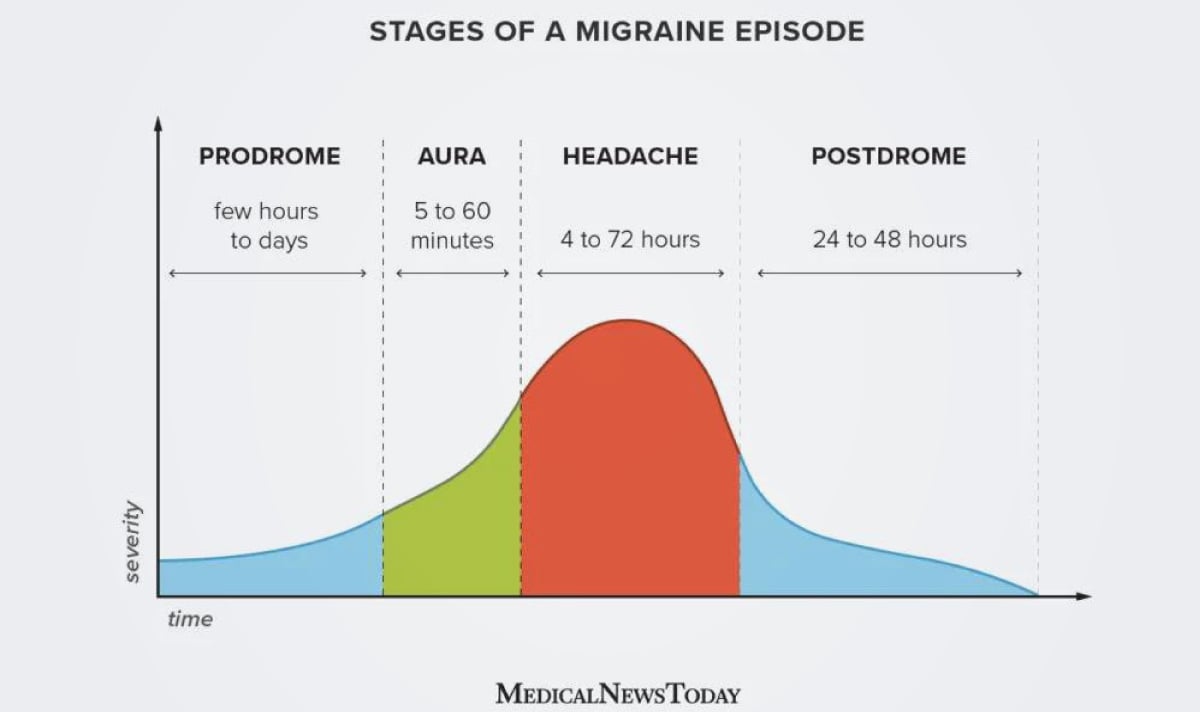Migraine is a type of severe headache disorder. The pain from migraines not only affects physical health but also impacts various aspects of life such as education, work, social interactions, and family.
How many phases of migraines are there?
Migraines can be divided into 4 phases as follows:
- 1. Prodrome Phase(Prodrome) Prodrome symptoms are found in up to 50% of patients and may occur up to 48 hours before the headache. Studies have shown abnormal functioning in the hypothalamus (Hypothalamus) during this phase. Common symptoms include:
- Fatigue
- Neck stiffness
- Mood changes
- 2. Aura Phase (Aura) About 25–30% of patients experience auras, which result from abnormal electrical changes on the surface of the brain (Cortical Spreading Depression) and can manifest in various ways such as:
- Seeing flickering lights, zigzag lines, dots, waves, or blurred vision (Visual Aura)
- Tingling sensations in the hands and arms or one side of the mouth (Sensory Aura)
- Speech disturbances (Dysphasic Aura)
Auras gradually develop over more than 5 minutes and typically disappear within 1 hour
- 3. Headache Phase (Headache) Migraine headaches can vary in nature, and the pain may be located on one side of the head, around the eyes, temples, back of the neck, or all over the head, such as:
- Throbbing pain like a pulsing artery
- Dull, heavy pressure or stabbing pain
The pain is often severe, accompanied by nausea or vomiting, sensitivity to light and sound, and head movements worsen the pain. If untreated, the headache phase can last up to 3 days
- 4. Postdrome Phase (Postdrome) Symptoms in this phase occur in up to 80% of patients but usually resolve within 24 hours. Common postdrome symptoms include:
- Fatigue
- Poor concentration
- Mood changes
- Neck stiffness

What are the symptoms before the onset of migraine?
Symptoms often occurring before migraine, in the phase without headache (Interictal Phase) include:
- Dizziness: Patients may feel unsteady or spinning
- Motion sickness – Easy sickness from vehicle or boat movement: Sensitive to motion while traveling
- Poor memory: Having problems remembering
- Sensitivity to the external environment: Sensitivity to bright light, loud noise, or strong smells
- Anxiety
- Depression
Why should you see a doctor when you have migraines?
Symptoms of migraines include more than just headaches. There are other symptoms resulting from abnormal brain functions in various areas. Recognizing migraine symptoms and triggers helps in better managing the condition. Proper care and treatment not only reduce headaches but also lessen other symptoms, improving the patient’s quality of life in the long term. Therefore, it is advisable to consult a doctor for appropriate guidance promptly.
Specialist in migraine treatment
Dr. Kiratikorn Vongvaivanich Neurologist, Bangkok International Hospital Brain and Spine Center
Hospital specializing in migraine treatment
Brain and Neuroscience Center, Bangkok International Hospital is dedicated to migraine treatment with a specialized medical team and interdisciplinary specialists using advanced technology to ensure high-quality life for patients every day.
Reference
- Takeshima T, Wan Q, Zhang Y, et al. Prevalence, burden, and clinical management of migraine in China, Japan, and South Korea: a comprehensive review of the literature. J Headache Pain. 2019;20(1):111. doi:10.1186/s10194-019-1062-4
- Dodick DW. A Phase‐by‐Phase Review of Migraine Pathophysiology. Headache. 2018;58(S1):4-16. doi:10.1111/head.13300
- Eigenbrodt AK, Christensen RH, Ashina H, et al. Premonitory symptoms in migraine: a systematic review and meta-analysis of observational studies reporting prevalence or relative frequency. J Headache Pain. 2022;23(1):140. doi:10.1186/s10194-022-01510-z
- Schulte LH, Mehnert J, May A. Longitudinal Neuroimaging over 30 Days: Temporal Characteristics of Migraine. Annals of Neurology. 2020;87(4):646-651. doi:10.1002/ana.25697
- Vongvaivanich K, Lertakyamanee P, Silberstein SD, Dodick DW. Late-life migraine accompaniments: A narrative review. Cephalalgia. 2015;35(10):894-911. doi:10.1177/0333102414560635
- Charles AC, Baca SM. Cortical spreading depression and migraine. Nat Rev Neurol. 2013;9(11):637-644. doi:10.1038/nrneurol.2013.192
- Kelman L. Migraine Pain Location: A Tertiary Care Study of 1283 Migraineurs. Headache. 2005;45(8):1038-1047. doi:10.1111/j.1526-4610.2005.05185.x
- Headache Classification Committee of the International Headache Society (IHS) The International Classification of Headache Disorders, 3rd edition. Cephalalgia. 2018;38(1):1-211. doi:10.1177/0333102417738202
- Giffin NJ, Lipton RB, Silberstein SD, Olesen J, Goadsby PJ. The migraine postdrome: An electronic diary study. Neurology. 2016;87(3):309-313. doi:10.1212/WNL.0000000000002789
- Vincent M, Viktrup L, Nicholson RA, Ossipov MH, Vargas BB. The not so hidden impact of interictal burden in migraine: A narrative review. Front Neurol. 2022;13:1032103. doi:10.3389/fneur.2022.1032103
